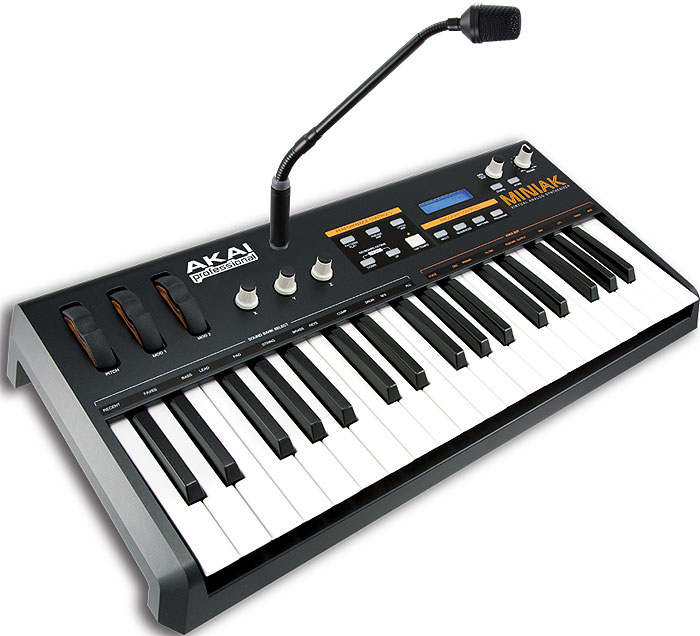- Amplifiers
- Beatmachines
- Cables & Wiring
- Cartridges
- Cases & Racks
- CD Players
- CD Recorders
- Compressors
- Crossovers
- Decksaver
- Digital DJ Gear
- DJ Tools
- Equalizers
- Headphones
- Installation
- Karaoke
- Keyboards
- Microphones
- MIDI Controllers
- Mixers
- Needles
- Packages
- Power Conditioners
- Production Packs
- Samplers
- Slipmats
- Software
- Software Controllers
- Sonic Maximizers
- Sound Cards
- Sound Effects
- Speakers
- Turntables
- Video Gear
- New Arrivals
- Blog
Home ›
DJ Keyboards › Akai MiniAK
Akai MiniAK


Akai MiniAK
Description
The MINIAK is a powerful performance and production synthesizer. The MINIAK empowers creative musicians with phrase and step sequencing, a built-in drum machine/rhythm sequencer, an arpeggiator, a 40-band vocoder, stereo effects, and a virtual analog synth engine developed in partnership with the world-class Alesis synth team. While the compact, portable synth shines on stage, the MINIAK is also at home in the production studio delivering 24-bit audio resolution.
The MINIAK puts up to eight multi-timbral voices at your fingertips, each with three oscillators. You can create interesting and unique sounds and take advantage of the more-than-600 preset sounds and store up to 1,000 programs in the MINIAK. The synth also has two multi-mode filters, three envelope generators, two LFOs, stereo effects, and a 40-band vocoder. On top of all of this sound-melding power, the MINIAK has a comprehensive sequencer with step and dynamic real time phrase sequencing, a drum machine/rhythm sequencer, and an arpeggiator to aid in creating the landscapes and textures you're after.
Rounding out this complete instrument are high-resolution, 24-bit balanced 1/4" inputs and outputs. The MINIAK has a 37-key semi-weighted keyboard with velocity sensitivity for all-in-one performance. It can also be used as a sound source for MPCs, computer software, and keyboards via MIDI.
UNDER THE HOOD
A MINIAK program is a sound built from the MINIAK's internal oscillators, filters, and envelope generators. The MINIAK's more than 600 preset programs span the range of classic analog synthesis sounds. If you've heard it before, you will probably find it in the MINIAK's presets.
In a synth, oscillators generate raw sound. Their output is fed into the filters, whose output is fed into the amplifiers. As the signal moves along that path, you can manipulate the mix at several points and apply modulations, envelopes, and effects to create a custom palette of sounds.
SOUND GENERATION
The oscillators can produce different waveform types and shapes to create various harmonic structures, which our ears perceive as different timbres. Here are some of the waveforms you can create with the MINIAK's oscillators:
- Sine – Smooth, pure sound
- Triangle – Fuller than a sine wave
- Sawtooth – Harsh sonic character
- Pulse – Harmonically rich, ranging from full-sounding square wave to a sharp impulse wave
The MINIAK's oscillators can produce continuously variable waveforms, so it can can hit any point between these examples.
You can connect external audio sources – other synthesizers, mixers, guitars, and more – using the 1/4" inputs. The jacks accept either balanced or unbalanced cables. You can mix in the external audio sources with the MINIAK's oscillators. The resulting combination is then sent through the MINIAK's filters and effects. A special group of programs including vocoder programs exists just for use with the external inputs.
The outputs of the oscillators, the noise generator, the ring modulator, and the external inputs are fed into a virtual mixing board called the pre-filter mix. From here, the signal hits the filters. For each source, you can specify its level and its balance: how much is sent to Filter 1 and how much is sent to Filter 2.
FILTERING
The oscillators produce very raw sounds. To shape and fine-tune the sound, filters give you tools for dampening certain harmonics and boosting others. Filters alter the frequency content of the signal and can have a drastic effect on the sound. Each of the MINIAK's voices contains two filters, and each filter can be one of the following different types, each with its own character and sonic flavor.
They are: Bypass, Low Pass: ob 2-pole, tb 3-pole, mg 4-pole, rp 4-pole, jp 4-pole, al 8-pole; Band Pass: ob 2-pole, al 6-pole, octave dual, band limit; High Pass: ob 2-pole, op 4-pole; three Vocal Formants, four Comb Filters, Phase Warp, Frequency, Resonance, Key Tracking, Envelope Amount, Offset, and Absolute.
After filtering, the signal is fed to the post-filter mix. For each filter output, as well as a pre-filter signal of your choice, you can specify a level and a pan.
OUTPUT PROCESSING
In the output stage, the MINIAK allows you to apply a drive effect and add some compression, distortion, or other amplification effects. The MINIAK allows you to set up twelve modulation routes. Each of these is a virtual connection between some physical or internally generated source and some program parameter. Basically, a mod route tells the synth to automatically grab a knob and tweak it while a note is playing. Although there are quite a few sources that you can use for your mods, the most common ones involve the LFOs and the envelopes.
LFOs
LFO stands for low-frequency oscillator. LFOs are not designed to produce sound, but instead to tweak a program parameter according to a looping pattern. For example, if you are looking to add vibrato, you need the pitch to continuously waver up and down. Each of the MINIAK's voices contains two LFOs, each of which offers rate, depth, shape, and tempo sync. The MINIAK's LFO can sync to the internal clock or any external source via MIDI.
ENVELOPES
If you hit a note on a piano, you hear a burst of sound energy as the hammer strikes the string, followed by lower level of loudness as you hold down the note and let the string ring out, which fades quickly as soon as you release the note and the damper is applied. Synthesizers model this behavior using ADSR Envelopes. ADSR stands for Attack, Decay, Sustain, and Release, and represents the different stages that the sound goes through over the life of the note. The MINIAK also has an envelope that is specifically designed for loudness, called the Amp Envelope. Envelopes are useful in all sorts of mod routes, which is why you can hook up any of the MINIAK's envelopes to any modulatable program parameter. Each of the MINIAK's voices contains three envelopes: Amp Envelope, Filter Envelope, and Pitch/Modulation Envelope.
SEQUENCING
The MINIAK has extensive sequencing and arpeggiation performance capabilities. Arpeggios and sequences both respond to a key-press by playing a series of notes over a programmed rhythmic pattern. An arpeggio loops over whatever notes you are holding down on the keyboard. If you hold down a chord, the MINIAK will generate a melody by playing each note of your chord individually. A sequence has a melody line built in so you can hold down a single key and the MINIAK will play back that melody relative to that key. Pressing another key will transpose the sequence.
The MINIAK has MPC-style step sequencing and recorder-style dynamic real time phrase sequencing. There's also a drum machine/rhythm sequencer for the built-in drum sounds.
EFFECTS
The MINIAK has a full compliment of stereo effects including Chorus, Feedback, Theta Flanger (Phaser + Flanger), Thru Zero Flanger, Super Phaser, Notch Frequency, String Phaser, 40-Band Vocoder, Analysis Gain, Sibilance Boost, Band Shift, Synthesis Input, Analysis Signal In, Analysis Mix, six types of Delay, and three types of Reverbs.
With the extensive sound generating and manipulating power of the MINIAK, the sounds you dream up are as easy to create as twisting a few knobs. And creating complete soundscapes with the sequencer and arpeggiator couldn't be easier. Step up to the only synth with the Akai Professional name... the MINIAK.
CONTACT US - BEAT A PRICE - GEAR RENTAL - TRACK YOUR PACKAGE - RETURNS / WARRANTY INFO ABOUT US - SHIPPING INFO - PURCHASE ORDERS - CUSTOM INSTALLATION - PRIVACY AND TERMS- BLOG
- Beacons
- Black Lights
- Bubble Machines
- Centerpiece Effects
- Clamps
- Flame Lights
- Fog Machines
- Fog Juice
- Follow Spots
- Gobo Projectors
- Intelligent Lighting
- Light Bags
- LED Lights
- Lasers
- Lighting Controllers
- Light Packages
- Mirror Balls
- Par Cans
- Party Accessories
- Pinspots
- Rope Lights
- Spare Bulbs
- Spark Machines
- Stands & Trussing
- Strobe Lights

If you don't see it, it doesn't mean we don't have it. If you are interested in a certain product, but don't see it on our website, please call us or e-mail us!
*All products subject to available stock.
Copyright © 2025 by www.123DJ.com





